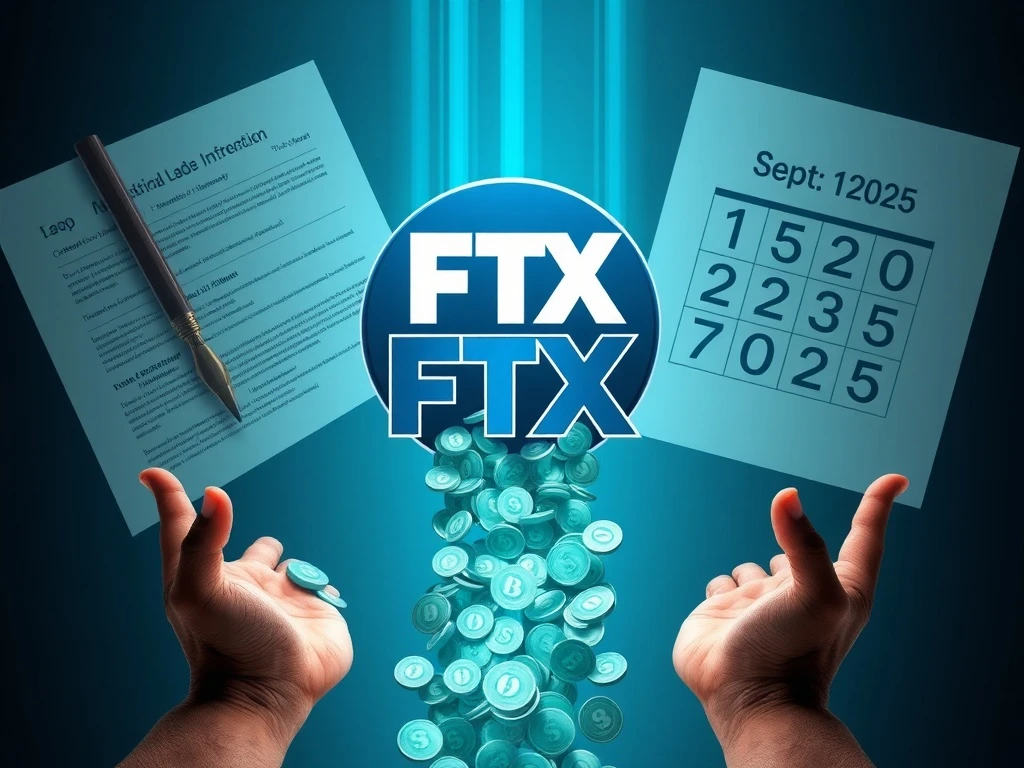FTX Payout: Historic Breakthrough as $1.9 Billion Disputed Claims Cut, Third Creditor Payout Set for September 2025

After years of uncertainty, a significant moment has arrived for those impacted by the FTX collapse. The defunct crypto exchange has secured crucial court approval to initiate its third round of creditor payouts, marking a substantial step forward in the FTX recovery process. This follows a massive $1.9 billion reduction in disputed claims reserves, freeing up much-needed funds. For millions of FTX creditors worldwide, the date to mark on their calendars is September 30, 2025, when the next FTX payout is slated to begin.
The Road to Recovery: What the FTX Payout Means for Creditors
The U.S. bankruptcy court’s recent decision is a game-changer. By lowering the contested reserve from an initial $6.5 billion to $4.3 billion, a significant portion of funds has been unlocked. This move directly benefits approved claims, including:
- Class 5 Customer Entitlement: This covers the majority of individual customer balances.
- Class 6 General Unsecured: For other general creditors who are not direct customers.
- Newly Allowed Convenience Claims: Smaller claims that are often expedited for efficiency.
This upcoming distribution isn’t the first, but it is one of the largest. It follows two prior successful distributions totaling an impressive $6.2 billion, with $1.2 billion paid out in February and another $5 billion in May. These payouts are part of a broader effort to repay the estimated $14.7 billion to $16.5 billion in total obligations, demonstrating tangible progress in the FTX recovery efforts.
Unpacking the Disputed Claims Reduction: A Crucial Step Forward
The reduction of disputed claims by $1.9 billion is more than just a number; it represents legal clarity and efficiency in a complex crypto bankruptcy case. By resolving a significant chunk of contested claims, the court has streamlined the path for distributions. This strategic decision aligns with the court’s emphasis on cash disbursements over digital assets, a move designed to mitigate crypto market volatility and align with traditional bankruptcy practices.
For eligible claimants, ensuring you receive your portion of the FTX payout requires adherence to specific deadlines:
- KYC Verification: All claimants must complete Know Your Customer verification.
- Tax Documents Submission: Necessary tax documentation must be submitted.
- Deadline: Both steps must be completed by August 15, 2025.
To ensure compliance with regulatory standards and facilitate smooth transactions, payments will be processed through established institutional custodians:
- BitGo
- Kraken
- Payoneer
This multi-platform approach aims to provide robust and secure channels for the disbursement of funds to FTX creditors.
Navigating the Complexities of Crypto Bankruptcy: A Global Challenge
While significant progress has been made, the FTX recovery journey is not without its hurdles. A major challenge lies in the 49 jurisdictions deemed “restricted,” particularly China, which accounts for a staggering 82% of the $800 million in remaining disputed claims. The FTX Recovery Trust has proposed excluding these regions from the current payout, citing compliance risks and the complexities of local regulations.
However, this exclusion has met with considerable legal pushback. Chinese users, represented by prominent claimant Weiwei Ji, who holds $15 million in verified claims, have vocally contested this restriction. Ji argues that crypto is recognized as legal property in China and that the exclusion is discriminatory and lacks legal basis. He also highlights alternative legal pathways through Hong Kong to challenge the restriction, underscoring the global intricacies of crypto bankruptcy.
The court is set to evaluate this contentious dispute during an omnibus hearing in July 2025. The outcome of this hearing could significantly redefine jurisdictional classifications and impact the distribution timeline for thousands of affected claimants. Critics express concern that excluding users based on broad regulatory assumptions might disproportionately affect smaller creditors who are less familiar with complex compliance protocols, raising important questions about equitable distribution in these unprecedented cases.
The Path Ahead: What’s Next for FTX Recovery?
The restructuring process of FTX continues to serve as a landmark case, highlighting the immense complexities of crypto insolvencies operating within evolving regulatory frameworks. While the phased FTX payout model sets a precedent for similar future cases, it also reveals inherent tensions between stringent compliance demands and the fundamental need for accessibility and fairness for all FTX creditors.
Optimistically, approximately 98% of creditors are projected to receive at least 119% of their claims based on bankruptcy valuations. This high recovery rate is a testament to the diligent work of the recovery team and the court’s focus on maximizing returns. However, it’s important to note that unresolved disputed claims and fragmented claim structures may prolong full resolution for some claimants for years to come.
The court’s continued focus on cash disbursements is a deliberate effort to stabilize repayments amidst ongoing legal challenges. This approach provides a clear, tangible return for creditors, bypassing the volatile nature of digital assets. Yet, the broader implications for how traditional bankruptcy frameworks adapt to crypto-specific complexities remain uncertain, as the legal landscape for digital assets is still developing.
As the September 30, 2025, FTX payout date approaches, it is crucial for creditors to finalize all necessary documentation and diligently monitor updates from the recovery trust. This case continues to test the boundaries of legal and financial systems, striving to balance regulatory compliance with fair compensation for all affected users.
Conclusion
The upcoming third FTX payout represents a significant milestone in one of the most high-profile crypto bankruptcy cases in history. The substantial reduction in disputed claims and the clear timeline for distributions offer a renewed sense of hope for thousands of FTX creditors. While challenges persist, particularly concerning restricted jurisdictions, the progress made underscores a concerted effort towards a resolution. This ongoing FTX recovery serves as a critical lesson and a developing blueprint for navigating the complexities of digital asset insolvencies in a rapidly evolving financial landscape.
Frequently Asked Questions (FAQs)
When is the next FTX payout scheduled?
The third round of FTX creditor payouts is scheduled to begin on September 30, 2025.
What is the deadline for eligible claimants to qualify for the FTX payout?
Eligible claimants must complete Know Your Customer (KYC) verification and submit all required tax documents by August 15, 2025, to qualify for disbursements.
How much in disputed claims has been reduced, and what does it mean for creditors?
The U.S. bankruptcy court approved a $1.9 billion reduction in disputed claims reserves, lowering the contested amount from $6.5 billion to $4.3 billion. This reduction frees up funds for approved claims, making the current FTX payout possible.
Which claim classes are eligible for this FTX payout?
The current payout includes funds for Class 5 Customer Entitlement, Class 6 General Unsecured, and newly allowed Convenience Claims.
Why are some jurisdictions considered “restricted,” and how does this affect claimants?
Certain jurisdictions, such as China, are deemed “restricted” due to compliance risks and complex local regulations. The FTX Recovery Trust has proposed excluding these regions from the current payout, which has led to legal challenges from claimants in those areas, potentially prolonging their resolution.
What percentage of their claims are creditors expected to receive?
Approximately 98% of FTX creditors are expected to receive at least 119% of their claims based on bankruptcy valuations, though full resolution for some may take longer due to unresolved disputes.









